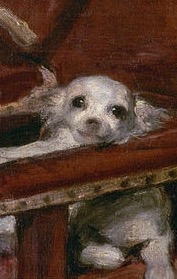In the original painting, Velazquez did not have the red cross of the Order of Santiago emblazoned on his chest; he only received it three years later. Philip IV ordered the cross to be added to the painting after the death of Velazquez. Legend has it that the King personally painted it.
The central figure is Princess Margarita Teresa, at the time the only living child of her parents, King Philip IV and his second wife Mariana of Austria. They’re in the background of the painting, possibly reflected in a strategically placed mirror. Also present are two ladies-in-waiting, two dwarves, a lady chaperone, a chamberlain, a bodyguard, and a friendly-looking mastiff. And the artist himself is present, with brush and palette. The names of all the people are known, except the bodyguard.
I’ll leave it to art historians to explicate what all Velazquez wanted to say in his magnum opus. I’m drawn to the enchanting figure of little Margarita Teresa, age 5. This was a golden moment in her short but seemingly happy life. The painting was almost destroyed by a fire in 1734. Fortunately, it was rescued. The left cheek of the princess was burned, but it was painstakingly restored.The spectacular Velazquez exhibit at the Vienna Kunsthistorisches Museum last year had to make do with a reproduction of Las Meninas. The masterpiece is too precious for the Prado to lend out.
One of the pleasures of a major museum exhibit is a stop at the gift shop. What souvenirs did the marketing people come up with? I thought they outdid themselves for the Velazquez exhibit.
Anyone for a t-shirt with the most fetching images from the great paintings? On the black cotton background, they show up almost as elegantly as the figures in Las Meninas.
Or how about a set of salt and pepper shakers? The salt is the adorable Margarita Teresa. The pepper is Diego Velazquez himself, complete with brush, palette and the cross of the Order of Santiago. I’m still kicking myself for not buying them.
An article about Picasso’s Las Meninas is at http://web.guggenheim.org/exhibitions/picasso/artworks/maids_of_honor
Join me next time for more explorations in the art and history of Europe!















































